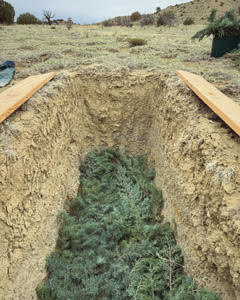Choosing eco-friendly burial materials is an essential part of planning a green burial. Biodegradable shrouds, caskets or containers honor the natural cycle of life and death by decomposing naturally, leaving no harmful impact on the environment. Whether you’re pre-planning for yourself or making arrangements for a loved one, this guide explores the best biodegradable and sustainable materials to consider for a meaningful and environmentally conscious burial.
1. Biodegradable Caskets
Biodegradable caskets are designed to decompose naturally, returning to the earth without leaving behind pollutants or waste. They should be constructed with as little hardware as possible and not finished with any paints or lacquers (oil would be an appropriate wood treatment). The handles and interior upholstery (if any) should also be made from natural materials.
Common materials include:
-
Unfinished Wood: Caskets made from untreated pine, poplar, or bamboo are simple, durable, and decompose naturally.
-
Wicker: Handwoven wicker caskets, made from willow or seagrass, are lightweight and particularly environmentally friendly because these materials are readily renewable..
-
Cardboard: An affordable and eco-friendly option, cardboard caskets are sturdy enough for burial while breaking down quickly in the soil.
What to consider: Look for caskets certified by organizations like the Green Burial Council to ensure they meet eco-friendly standards.
2. Burial Shrouds
A burial shroud is a simple, biodegradable cloth used to wrap the body directly, eliminating the need for a casket altogether. Shrouds are often used in green burials to allow the body to decompose naturally.
Common materials include:
-
Organic Cotton: Soft, natural, and free from synthetic dyes or chemicals.
-
Hemp: Durable and highly sustainable, hemp is an excellent choice for shrouds.
-
Linen: Lightweight and biodegradable, linen shrouds offer a natural and elegant option.
-
Silk: Could be used for the entire shroud or as decorative accents.
What to consider: Many shrouds include built-in straps and stiffening backboard to make transportation and lowering into the grave easier. If the shroud does not have these, a carrying board or basket may be necessary.
3. Biodegradable Urns
For cremation remains, biodegradable urns allow families to return ashes to the earth or water in a sustainable way. These urns are crafted from materials that naturally break down over time.
Common materials include:
-
Salt: Urns made from compacted salt dissolve in water, making them ideal for sea burials. These are not suitable for earth burial because the salt would be damaging to plant life.
-
Sand or Unfired Clay: These urns degrade naturally in the soil, enriching the earth as they decompose.
-
Paper or Plant Fiber: Lightweight and versatile, paper-based urns are perfect for scattering or planting.
What to consider: Choose urns designed for your preferred memorial method, such as soil interment or water scattering. If you are burying or scattering cremated remains, be aware that ashes are salty and high in pH, and can be damaging to the soil health. You can use a soil amendment mix designed to improve the chemistry of the ashes and give the cremation back to the earth in a sustainable way.
4. Mushroom-Based Containers
Mycelium as a construction material is appropriate for natural burial because it is a renewable material and breaks down readily in the soil. There is no evidence that decomposition of the body is improved by the presence of the fungus.
What to consider: There is no need to imbue the container with mushroom spores, because native fungal spores are already present in the soil. It is more environmentally friendly to avoid introducing non-native fungal spores into the burial place.
5. Avoid Vaults or Burial Liners
Though some cemeteries require an outer burial container, green burials generally avoid these conventional concrete vaults or liners. Burying with a vault represents an extra expense and usage of virgin materials which is not necessary for safe and dignified interment. Instead, green burials should take place at a grave depth of 3.5 – 4 feet and the soil can be mounded to compensate for settling.
Check with your burial site to see if liners are required. The Green Burial Council does not recognize any outer burial container as eco-friendly.
6. Eco-Friendly Accessories
Even small details in a green burial can make a difference. Accessories like biodegradable headstones or grave markers can complete the eco-friendly burial process.
Examples include:
-
Natural Stones: Uncarved or engraved rocks that blend into the natural landscape.
-
Plant Markers: Trees, flowers, or shrubs planted to mark a gravesite.
-
Wooden Plaques: Simple, untreated wood markers that decompose naturally over time.
What to consider: Many green cemeteries offer specific guidelines for markers to maintain the natural aesthetic of the burial ground.
Why Choose Eco-Friendly Burial Materials?
Using eco-friendly materials not only reduces the environmental impact of burial but also creates a meaningful connection to nature. These materials honor the cycle of life and death, ensuring that burial contributes to the health of the planet rather than harming it.
By choosing renewable and biodegradable caskets, shrouds, urns, and accessories, you’re making a statement about sustainability and leaving a legacy rooted in care for the earth.
Key Takeaways
Eco-friendly burial materials are an integral part of green burials, offering a sustainable and meaningful way to honor life. From biodegradable caskets to natural grave markers, these materials ensure that your final resting place aligns with your values and protects the environment.
For more information and resources on green burials, visit our Green Burial Hub and explore additional guides to help you plan an eco-friendly farewell.
If you have feedback, questions, or ideas for future articles or Information Hubs, please contact us. Your insights help us create valuable content.


